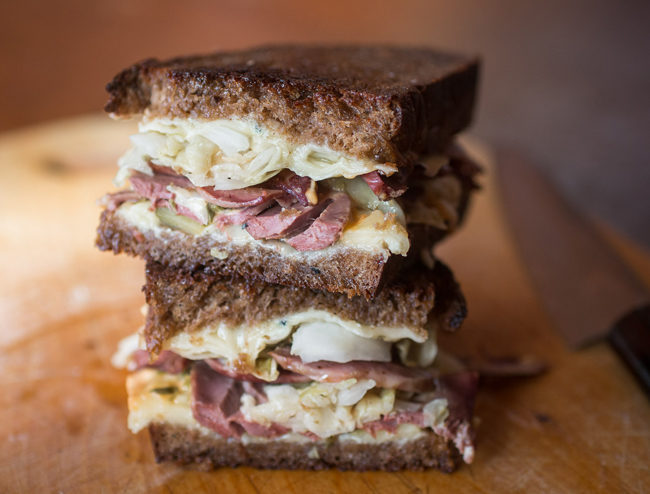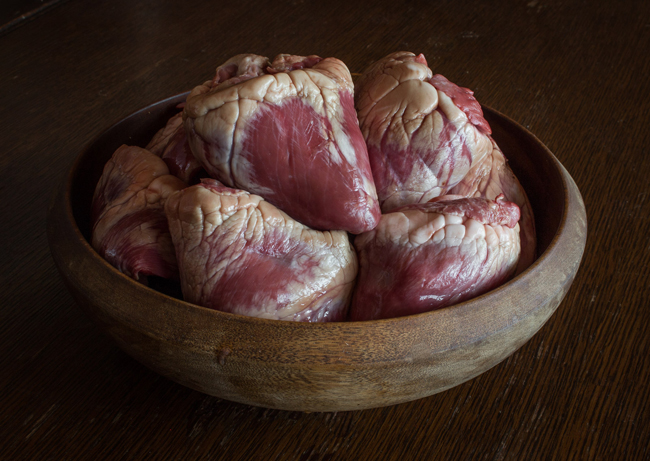
This post is sponsored by Shepherd Song Farm and written by Chef Alan Bergo of Forager | Chef.
The day after Christmas, it’s Valentine’s season. Walk into any grocery store and you’ll be bombarded with an endless array of heart-shaped signs and symbols. The aisles are festooned with heart-laden banners. The walls are decked out with paper hearts, some creatively colored in by local kids, most in a range of traditional pinks and reds.
Around Valentine’s Day, we’re surrounded by hearts, both as marketing symbols and as signs of endearment, but for the most part, unless they’re made of chocolate or cookie dough, hearts are not something we eat.
Perhaps no heart today seems quite so inedible as the heart of an actual animal. Once coveted as a delicacy, that kind of heart is now considered strange — a piece of forbidden, alien meat we glance over in the frozen section, with ice crystals from the deep freeze reinforcing our notion that no, no one eats that, and neither will I: Where are the steaks, tenders, and chops again?
When I was growing up, I was squeamish about eating heart, along with most other organ meats. But when I started cooking, I gradually came to appreciate both the ethical and practical value of eating the whole animal. I also began exploring the culinary potential of less-popular bits, including heart. And, with experience, I grew to love and respect this meat’s unique properties.

We all want to share our passions and strongly held beliefs with others. And “eat the whole animal” is a tenet I believe in fiercely. But what I learned from experience is what most seasoned chefs already know: Heart is a very hard restaurant sell. And in a restaurant setting, the inability to sell heart can quickly translate into a lack of desire to cook it.
This is true for home cooks, too, of course. Even the most inspired drive to creatively elevate and celebrate offal will quickly fizzle if there’s nobody to appreciate the results. To see beautiful hearts carefully prepped and served, only to be pushed around a plate and later tossed in the trash is, well, heartbreaking.
Happily, there’s one way to cook heart that’ll win over just about anyone: corning. Corning has a transformative effect on both the flavors and textures that are so often presented as organ-meat deal-breakers.
After meat sits in a brine for a while and then gets thoroughly cooked, there’s a safe and comforting homogeneity to it. Everything gets soft, tender, and seasoned to a slightly salty perfection.
So, here, I’m going to give you my recipe for corned lamb or goat hearts from Shepherd Song Farm, a great 100 percent grass-fed lamb and goat operation in Downing, Wis. This method of corning is a great way to bring out the best not just in hearts, but in all sorts of other organ and muscle meats, especially game that must be cooked through before eating.
Amy Thielen uses corning to make bear-meat pastrami in Northern Minnesota, and my friend Hank Shaw uses the process for venison (as well just about as anything that flies). The possibilities are limitless.
So, what do you make out of the corned heart you prepare? Since the meat has already been cooked, and the heart is lean, you don’t want to apply too much direct heat (so no grilling), but slicing and gently warming corned heart in a pan is great.
I love to make warm Reuben sandwiches out of corned heart. Here’s a simple recipe and video describing my process. If you feel like trying goat or lamb hearts, as I have pictured, here’s the link to Shepherd Song. Know that hearts from larger animals like pork and beef can take longer to cure.

CORNED LAMB OR GOAT HEARTS
Alan Bergo
Yield: enough to serve 3-4 people for lunch or as a light entree
Equipment:
• Deep covered braising pan, Dutch oven, or casserole capable of holding 1 gallon of liquid
• Plastic container for refrigerating the hearts, capable of holding 1 gallon of liquid
• Large plastic bag, or a plate or other weight for keeping the hearts submerged in the brine while they cure (see directions)
For the Brine:
2 quarts water
½ cup brown sugar
½ cup kosher salt
2½ teaspoons Prague powder #1 (pink curing salt)
1 tablespoon chopped garlic
1 heaping tablespoons pickling spices
1 tablespoon chopped ginger
4 lamb or goat hearts, roughly 2 pounds, total weight
For the final braise:
1 medium carrot, chopped
1 medium yellow onion, chopped
1 rib of celery, chopped
1 tablespoon chopped ginger
1 heaping tablespoon pickling spices
1. Toast the pickling spices. Then combine with the remaining brine ingredients and bring to a simmer. Cook for 5 minutes, stirring occasionally. Cool the brine to room temperature, and transfer to a container big enough to accommodate both the brine and the hearts.
2. Make a cut down one side of each heart so the hearts can be opened up like a book. Hearts often come already slit.
3. Put the hearts in the cooled brine. Then place a weight (a small saucer or something similar) on top to keep the hearts under the liquid as much as possible. Alternately, open a large plastic freezer bag over the sides of the container, press down, and fill halfway with cold water, just enough so that the hearts are kept under the brine. Then cover the top in plastic or with a lid, to avoid spilling. There are lots of ways to keep the meat under the brine, and as long as it’s underneath the liquid, it will cure just fine.
4. After four days, remove the hearts from the brine and fit snugly into a pan with the 4 cups of water, the remaining heaping tablespoon of toasted pickling spice, and the chopped carrot, onion, celery, and ginger. If 4 cups of water isn’t enough to cover the hearts, add more until they’re just starting to float. Bring the mixture to a gentle simmer, cover, and cook for 2 hours, or until the hearts are tender.
5. Allow the hearts to cool in their liquid until you can handle them, then remove and trim off some the fat and remove the large central vein.
6. For storage, strain the liquid and keep the hearts in their cooking liquid so they don’t dry out. The hearts will keep in their liquid for 5 days. They can also be wrapped tightly in plastic, labeled, dated, and frozen for 3 months.
Editor’s note: the recipe was updated on Feb. 14 to clarify that pink salt is another name for Prague powder, a curing salt that contains sodium nitrite. It is not the same as Himalayan or Hawaiian salt.

